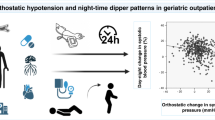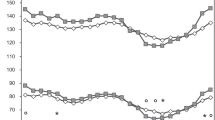Abstract
Ankylosing spondylitis (AS) is associated with an increased risk of cardiovascular morbidity and mortality. Parameters, such as non-dipper, average real variability (ARV), pulse pressure index (PPI), and ambulatory arterial stiffness index (AASI) obtained from ambulatory blood pressure monitoring (ABPM), provide information about adverse cardiovascular outcomes. In this study, these indexes were evaluated in patients with AS. Sixty-five patients with AS and 65 control subjects were included in this study. Non-dipper pattern, ARV, PPI, and AASI parameters were assessed using 24-h ABPM recordings. Twenty-four-hour systolic, diastolic, mean standard deviation, PPI, ARV, and AASI were higher in patients with AS (p < 0.05 all parameters). Non-dipper (43.1% vs. 21.5%, p = 0.007) and reverse dipper (10.8% vs. 0%, p = 0.013) patterns were more common in patients with AS. In addition, disease duration was moderately correlated with AASI and ARV (r = 0.36, p = 0.003; r = 0.31, p = 0.012, respectively). This study showed that PPI, AASI, ARV, and dipper pattern were impaired in patients with AS evaluated with ABPM.
This is a preview of subscription content, access via your institution
Access options
Subscribe to this journal
Receive 12 digital issues and online access to articles
$119.00 per year
only $9.92 per issue
Buy this article
- Purchase on Springer Link
- Instant access to full article PDF
Prices may be subject to local taxes which are calculated during checkout

Similar content being viewed by others
References
Van der Linden S, Valkenburg HA, Cats A. Evaluation of diagnostic criteria for ankylosing spondylitis. A proposal for modification of the New York criteria. Arthritis Rheumatol. 1984;27:361–8.
Lehtinen K. Mortality and causes of death in 398 patients admitted to hospital with ankylosing spondylitis. Ann Rheum Dis. 1993;52:174–6.
Bai R, Zhang Y, Liu W, Ma C, Chen X, Yang J, et al. The relationship of ankylosing spondylitis and subclinical atherosclerosis: a systemic review and meta-analysis. Angiology. 2019;70:492–500.
Candemir M, Candemir B, Ertürk A. Evaluation of cardiac autonomic nervous system in patients with ankylosing spondylitis using 12-lead electrocardiography and Holter monitoring. Clin Rheumatol. 2020;39:2631–9.
Williams B, Mancia G, Spiering W, Agabiti Rosei E, Azizi M, Burnier M, et al. 2018 ESC/ESH Guidelines for the management of arterial hypertension: The Task Force for the management of arterial hypertension of the European Society of Cardiology and the European Society of Hypertension: The Task Force for the management of arterial hypertension of the European Society of Cardiology and the European Society of Hypertension. J Hypertens. 2018;36:1953–2041.
Roush GC, Fagard RH, Salles GF, Pierdomenico SD, Reboldi G, Verdecchia P, et al. Prognostic impact from clinic, daytime, and night-time systolic blood pressure in nine cohorts of 13,844 patients with hypertension. J Hypertens. 2014;32:2332–40. discussion 2340
Sahinarslan A, Gazi E, Aktoz M, Ozkan C, Ulusal Okyay G, Ucar, et al. Consensus paper on the evaluation and treatment of resistant hypertension by the Turkish Society of Cardiology. Anatol J Cardiol. 2020;24:137–52.
Avram C, Drăgoi RG, Popoviciu H, Drăgoi M, Avram A, Amaricăi E. Association between arterial stiffness, disease activity and functional impairment in ankylosing spondylitis patients: a cross-sectional study. Clin Rheumatol. 2016;35:2017–22.
Peters MJ, van Eijk IC, Smulders YM, Serne E, Dijkmans BA, van der Horst-Bruinsma IE, et al. Signs of accelerated preclinical atherosclerosis in patients with ankylosing spondylitis. J Rheumatol. 2010;37:161–6.
Devereux RB, Alderman MH. Role of preclinical cardiovascular disease in the evolution from risk factor exposure to development of morbid events. Circulation. 1993;88:1444–55.
Garrett S, Jenkinson T, Kennedy LG, Whitelock H, Gaisford P, Calin A. A new approach to defining disease status in ankylosing spondylitis: the Bath Ankylosing Spondylitis Disease Activity Index. J Rheumatol. 1994;21:2286–91.
Parati G, Stergiou G, O’Brien E, Asmar R, Beilin L, Bilo G, et al. European Society of Hypertension practice guidelines for ambulatory blood pressure monitoring. J Hypertens. 2014;32:1359–66.
Hansen TW, Thijs L, Li Y, Boggia J, Kikuya M, Björklund-Bodegård K, et al. Prognostic value of reading-to-reading blood pressure variability over 24 h in 8938 subjects from 11 populations. Hypertension. 2010;55:1049–57.
Whelton SP, McEvoy JW, Shaw L, Psaty BM, Lima JAC, Budoff M, et al. Association of normal systolic blood pressure level with cardiovascular disease in the absence of risk factors. JAMA Cardiol. 2020;5:1011–8.
Coccina F, Pierdomenico AM, Cuccurullo C, Pierdomenico SD. Prognostic value of average real variability of systolic blood pressure in elderly treated hypertensive patients. Blood Press Monit. 2019;24:179–84.
Peng-Lin Y, Yue-Chun L. Pulse pressure index (pulse pressure/systolic pressure) may be better than pulse pressure for assessment of cardiovascular outcomes. Med Hypotheses. 2009;72:729–31.
Li Y, Wang JG, Dolan E, Gao PJ, Guo HF, Nawrot T, et al. Ambulatory arterial stiffness index derived from 24-hour ambulatory blood pressure monitoring. Hypertension. 2006;47:359–64.
Wei CY, Kung WM, Chou YS, Wang YC, Tai HC, Wei JC. Cardiac autonomic function in patients with ankylosing spondylitis: a case-control study. Medicine. 2016;95:e3749.
Salles GF, Reboldi G, Fagard RH, Cardoso CR, Pierdomenico SD, Verdecchia P, et al. Prognostic effect of the nocturnal blood pressure fall in hypertensive patients: the Ambulatory Blood Pressure Collaboration in Patients With Hypertension (ABC-H) meta-analysis. Hypertension. 2016;67:693–700.
Soylu A, Yazici M, Duzenli MA, Tokac M, Ozdemir K, Gok H. Relation between abnormalities in circadian blood pressure rhythm and target organ damage in normotensives. Circ J. 2009;73:899–904.
Boggia J, Li Y, Thijs L, Hansen TW, Kikuya M, Björklund-Bodegård K, et al. Prognostic accuracy of day versus night ambulatory blood pressure: a cohort study. Lancet. 2007;370:1219–29.
Smith TO, Sillito JA, Goh CH, Abdel-Fattah AR, Einarsson A, Soiza RL, et al. Association between different methods of assessing blood pressure variability and incident cardiovascular disease, cardiovascular mortality and all-cause mortality: a systematic review. Age Ageing. 2020;49:184–92.
Palatini P, Reboldi G, Beilin LJ, Casiglia E, Eguchi K, Imai Y, et al. Added predictive value of night-time blood pressure variability for cardiovascular events and mortality: the Ambulatory Blood Pressure-International Study. Hypertension. 2014;64:487–93.
Chowdhury EK, Wing LMH, Jennings GLR, Beilin LJ, Reid CM. Visit-to-visit (long-term) and ambulatory (short-term) blood pressure variability to predict mortality in an elderly hypertensive population. J Hypertens. 2018;36:1059–67.
JCS Joint Working Group. Guidelines for the clinical use of 24 h ambulatory blood pressure monitoring (ABPM) (JCS 2010): digest version. Circ J. 2012;76:508–19.
Mathieu S, Pereira B, Couderc M, Rabois E, Dubost JJ, Soubrier M. No significant changes in arterial stiffness in patients with ankylosing spondylitis after tumour necrosis factor alpha blockade treatment for 6 and 12 months. Rheumatology. 2013;52:204–9.
Hatipsoylu E, Şengül İ, Kaya T, Karatepe AG, Akçay S, Isayeva L, et al. Assessment of subclinical atherosclerotic cardiovascular disease in patients with ankylosing spondylitis. Anatol J Cardiol. 2019;22:185–91.
Dart AM, Kingwell BA. Pulse pressure-a review of mechanisms and clinical relevance. J Am Coll Cardiol. 2001;37:975–84.
Craiem D, Graf S, Salvucci F, Chironi G, Megnien JL, Simon A, et al. The physiological impact of the nonlinearity of arterial elasticity in the ambulatory arterial stiffness index. Physiol Meas. 2010;31:1037–46.
Laugesen E, Hansen KW, Knudsen ST, Erlandsen M, Ebbehøj E, Poulsen PL. Reproducibility of the ambulatory arterial stiffness index in patients with type 1 diabetes mellitus. Blood Press Monit. 2010;15:18–22.
Cai A, Mo Y, Zhang Y, Li J, Chen J, Zhou Y, et al. Relationship of pulse pressure index and carotid intima-media thickness in hypertensive adults. Clin Exp Hypertens. 2015;37:267–70.
Dolan E, Thijs L, Li Y, Atkins N, McCormack P, McClory S, et al. Ambulatory arterial stiffness index as a predictor of cardiovascular mortality in the Dublin Outcome Study. Hypertension. 2006;47:365–70.
Leoncini G, Ratto E, Viazzi F, Vaccaro V, Parodi A, Falqui V, et al. Increased ambulatory arterial stiffness index is associated with target organ damage in primary hypertension. Hypertension. 2006;48:397–403.
Hansen TW, Staessen JA, Torp-Pedersen C, Rasmussen S, Li Y, Dolan E, et al. Ambulatory arterial stiffness index predicts stroke in a general population. J Hypertens. 2006;24:2247–53.
Author information
Authors and Affiliations
Contributions
Concept: MC, BCandemir; design: MC, BCandemir, EK; supervision: MC, BCandemir, SN, AŞ; materials: MC, BCandemir, BCihan, SN; data collection and/or processing: MC, BCandemir, BCihan, SN; analysis and/or interpretation: MC, EK, BCihan; literature search: MC, BCandemir, AŞ; writing: MC, EK, AŞ; critical review: MC, AŞ.
Corresponding author
Ethics declarations
Conflict of interest
The authors declare no competing interests.
Additional information
Publisher’s note Springer Nature remains neutral with regard to jurisdictional claims in published maps and institutional affiliations.
Rights and permissions
About this article
Cite this article
Candemir, M., Kiziltunç, E., Candemir, B. et al. Analysis of ambulatory blood pressure monitoring data in patients with ankylosing spondylitis without clinically evident cardiovascular disease. J Hum Hypertens 36, 531–536 (2022). https://doi.org/10.1038/s41371-021-00542-3
Received:
Revised:
Accepted:
Published:
Issue Date:
DOI: https://doi.org/10.1038/s41371-021-00542-3



